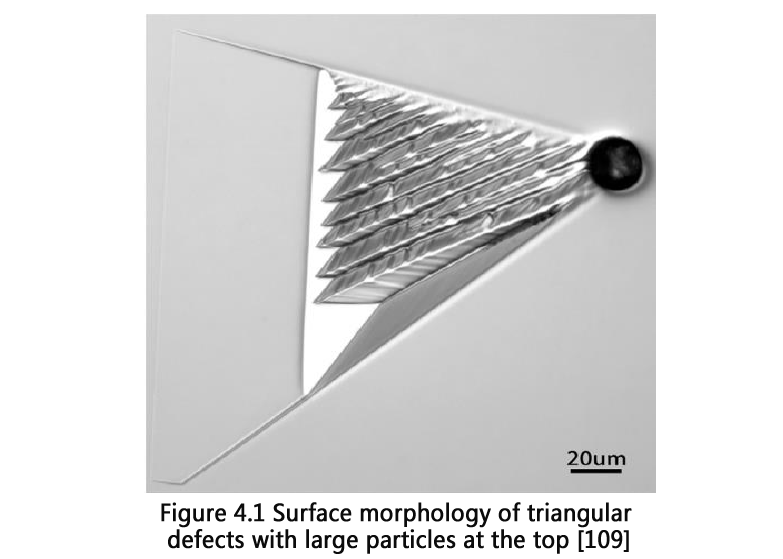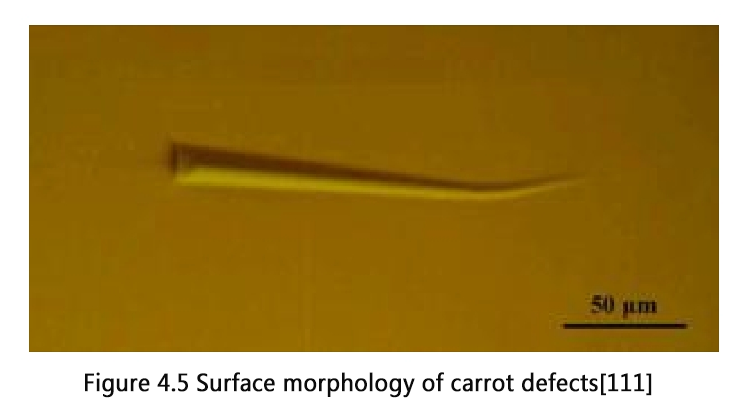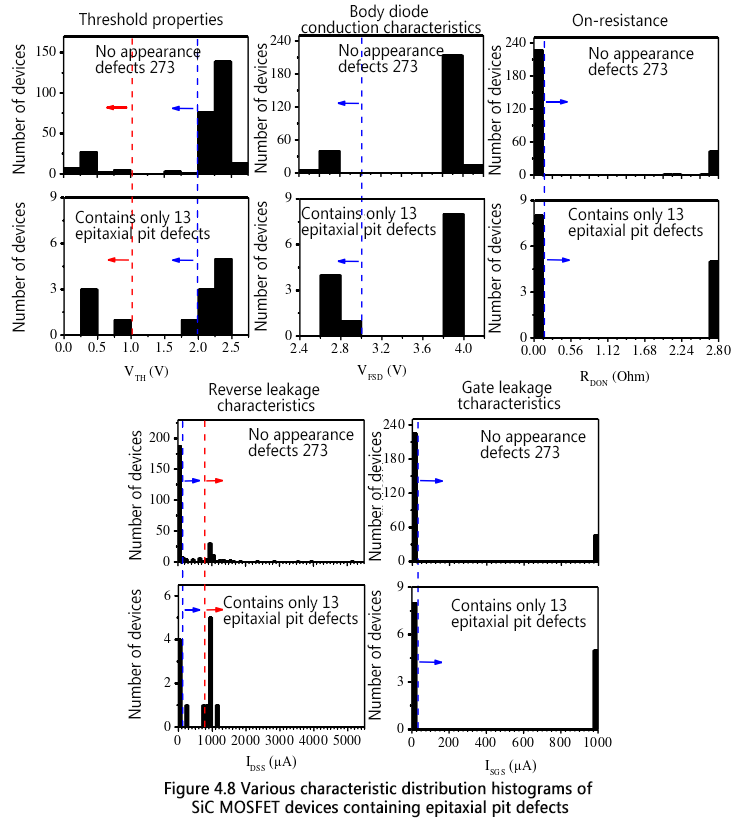Triangular defect
Triangular defects are the most fatal morphological defects in SiC epitaxial layers. A large number of literature reports have shown that the formation of triangular defects is related to the 3C crystal form. However, due to different growth mechanisms, the morphology of many triangular defects on the surface of the epitaxial layer is quite different. It can be roughly divided into the following types:
(1) There are triangular defects with large particles at the top
This type of triangular defect has a large spherical particle at the top, which may be caused by falling objects during the growth process. A small triangular area with a rough surface can be observed downward from this vertex. This is due to the fact that during the epitaxial process, two different 3C-SiC layers are formed successively in the triangular area, of which the first layer is nucleated at the interface and grows through the 4H-SiC step flow. As the thickness of the epitaxial layer increases, the second layer of 3C polytype nucleates and grows in smaller triangular pits, but the 4H growth step does not completely cover the 3C polytype area, making the V-shaped groove area of 3C-SiC still clearly visible

(2) There are small particles at the top and triangular defects with rough surface
The particles at the vertices of this type of triangular defect are much smaller, as shown in Figure 4.2. And most of the triangular area is covered by the step flow of 4H-SiC, that is, the entire 3C-SiC layer is completely embedded under the 4H-SiC layer. Only the growth steps of 4H-SiC can be seen on the triangular defect surface, but these steps are much larger than the conventional 4H crystal growth steps.

(3) Triangular defects with smooth surface
This type of triangular defect has a smooth surface morphology, as shown in Figure 4.3. For such triangular defects, the 3C-SiC layer is covered by the step flow of 4H-SiC, and the 4H crystal form on the surface grows finer and smoother.
Epitaxial pit defects
Epitaxial pits (Pits) are one of the most common surface morphology defects, and their typical surface morphology and structural outline are shown in Figure 4.4. The location of the threading dislocation (TD) corrosion pits observed after KOH etching on the back of the device has a clear correspondence with the location of the epitaxial pits before device preparation, indicating that the formation of epitaxial pit defects is related to threading dislocations.
carrot defects
Carrot defects are a common surface defect in 4H-SiC epitaxial layers, and their typical morphology is shown in Figure 4.5. The carrot defect is reported to be formed by the intersection of Franconian and prismatic stacking faults located on the basal plane connected by step-like dislocations. It has also been reported that the formation of carrot defects is related to TSD in the substrate. Tsuchida H. et al. found that the density of carrot defects in the epitaxial layer is proportional to the density of TSD in the substrate. And by comparing the surface morphology images before and after epitaxial growth, all observed carrot defects can be found to correspond to the TSD in the substrate. Wu H. et al. used Raman scattering test characterization to find that the carrot defects did not contain the 3C crystal form, but only the 4H-SiC polytype.
Effect of triangular defects on MOSFET device characteristics
Figure 4.7 is a histogram of the statistical distribution of five characteristics of a device containing triangular defects. The blue dotted line is the dividing line for device characteristic degradation, and the red dotted line is the dividing line for device failure. For device failure, triangular defects have a great impact, and the failure rate is greater than 93%. This is mainly attributed to the influence of triangular defects on the reverse leakage characteristics of devices. Up to 93% of devices containing triangular defects have significantly increased reverse leakage. In addition, the triangular defects also have a serious impact on the gate leakage characteristics, with a degradation rate of 60%. As shown in Table 4.2, for threshold voltage degradation and body diode characteristic degradation, the impact of triangular defects is small, and the degradation proportions are 26% and 33% respectively. In terms of causing an increase in on-resistance, the impact of triangular defects is weak, and the degradation ratio is about 33%.
Effect of epitaxial pit defects on MOSFET device characteristics
Figure 4.8 is a histogram of the statistical distribution of five characteristics of a device containing epitaxial pit defects. The blue dotted line is the dividing line for device characteristic degradation, and the red dotted line is the dividing line for device failure. It can be seen from this that the number of devices containing epitaxial pit defects in the SiC MOSFET sample is equivalent to the number of devices containing triangular defects. The impact of epitaxial pit defects on device characteristics is different from that of triangular defects. In terms of device failure, the failure rate of devices containing epitaxial pit defects is only 47%. Compared with triangular defects, the impact of epitaxial pit defects on the reverse leakage characteristics and gate leakage characteristics of the device is significantly weakened, with degradation ratios of 53% and 38% respectively, as shown in Table 4.3. On the other hand, the impact of epitaxial pit defects on threshold voltage characteristics, body diode conduction characteristics and on-resistance is greater than that of triangular defects, with the degradation ratio reaching 38%.
In general, two morphological defects, namely triangles and epitaxial pits, have a significant impact on the failure and characteristic degradation of SiC MOSFET devices. The existence of triangular defects is the most fatal, with a failure rate as high as 93%, mainly manifested as a significant increase in reverse leakage of the device. Devices containing epitaxial pit defects had a lower failure rate of 47%. However, epitaxial pit defects have a greater impact on the device’s threshold voltage, body diode conduction characteristics and on-resistance than triangular defects.
Post time: Apr-16-2024












